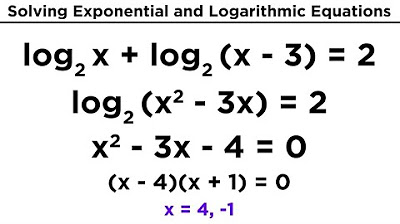Resolver ecuaciones exponenciales con logaritmos | Ejemplo 1
Summary
TLDRIn this educational video, the instructor explains how to solve exponential equations that cannot be simplified into a single base. The process involves applying natural logarithms to both sides of the equation to simplify and isolate the variable. The instructor demonstrates two example exercises, focusing on explaining the steps of applying logarithms and solving for the unknown variable. The video provides clear, easy-to-follow explanations and encourages viewers to practice the methods on their own for better understanding. The video concludes with a challenge for viewers to solve a more complex problem, reinforcing the learned concepts.
Takeaways
- 😀 The video covers the concept of solving exponential equations using logarithms when the bases are not the same.
- 😀 Logarithms are essential for handling exponential equations where bases cannot be converted into powers of each other.
- 😀 The natural logarithm (ln) is commonly used for simplifying equations involving exponents, as it helps bring the exponent down for easier manipulation.
- 😀 A key logarithmic property is that an exponent can be brought in front of the logarithm to simplify the equation.
- 😀 When applying logarithms to both sides of an equation, the logarithmic function is applied to the entire expression, including the exponent.
- 😀 To solve for the variable in an exponential equation, the logarithmic equation is simplified by isolating the variable.
- 😀 Calculators are used to compute the logarithms and assist in finding approximate values for the solutions.
- 😀 The final solution of an exponential equation may require approximation, especially when dealing with decimals or irrational numbers.
- 😀 Verification of the solution can be done by substituting the value of the variable back into the original equation to check if both sides are approximately equal.
- 😀 The video stresses the importance of rounding values appropriately to avoid discrepancies in the final result.
- 😀 The tutorial emphasizes practicing more complex examples to better understand how to apply logarithms and solve different types of exponential equations.
Q & A
What is the key difference between the equations discussed in the video and previous ones?
-The key difference is that the bases of the equations are not the same, meaning they cannot be converted to each other easily. For example, the bases in the first equation are 2 and 7, and there's no way to express 7 as a power of 2.
Why can’t the equation 2^x = 7 be solved by simply applying the rule where equal bases imply equal exponents?
-This rule can only be applied when the bases of both sides of the equation are the same. Since the bases here are different (2 and 7), we need to use logarithms to solve the equation.
What role do logarithms play in solving exponential equations like 2^x = 7?
-Logarithms are used to transform the exponents into a more manageable form, allowing us to solve for the unknown variable. By applying the logarithm to both sides, we can bring the exponent down and solve for x.
What are the two types of logarithms commonly used in solving such equations, and why is the natural logarithm (ln) often chosen?
-The two types of logarithms commonly used are the base-10 logarithm and the natural logarithm (ln). The natural logarithm is often chosen because it involves fewer characters (ln instead of 'log'), making the calculations simpler and faster.
What is the important property of logarithms that helps in solving exponential equations?
-The important property is that when applying the logarithm to a power, the exponent can be brought out as a coefficient. For example, log(x^n) = n * log(x), which makes solving for the exponent easier.
How is the equation 2^x = 7 solved step-by-step using logarithms?
-First, apply the natural logarithm (ln) to both sides: ln(2^x) = ln(7). Then, use the logarithm property to bring the exponent down: x * ln(2) = ln(7). Finally, solve for x by dividing both sides by ln(2), giving x = ln(7) / ln(2).
How do we ensure the accuracy of the answer when using logarithms in calculations?
-We ensure accuracy by calculating the logarithms with sufficient decimal places and rounding off appropriately. For example, when using a calculator, you can get a more precise value by carrying more decimal places before rounding off the final result.
How can the solution be verified after calculating x?
-To verify the solution, substitute the value of x back into the original equation. For example, if x ≈ 2.81, check if 2^2.81 ≈ 7. The result should be very close to the value on the right-hand side of the original equation.
What should be considered when applying logarithms to both sides of an equation?
-It is crucial to remember that logarithms must be applied correctly, especially ensuring that the logarithmic operation affects the entire expression on one side. Also, when there are multiple terms in the exponent, the logarithm should be applied to the entire argument.
In the second example, how does applying logarithms help simplify the equation 3^(x+2) = 10?
-By applying the natural logarithm to both sides, we bring the exponent (x+2) down. This allows us to create a linear equation where the variable is no longer in the exponent, making it easier to solve.
Outlines

This section is available to paid users only. Please upgrade to access this part.
Upgrade NowMindmap

This section is available to paid users only. Please upgrade to access this part.
Upgrade NowKeywords

This section is available to paid users only. Please upgrade to access this part.
Upgrade NowHighlights

This section is available to paid users only. Please upgrade to access this part.
Upgrade NowTranscripts

This section is available to paid users only. Please upgrade to access this part.
Upgrade NowBrowse More Related Video
5.0 / 5 (0 votes)





